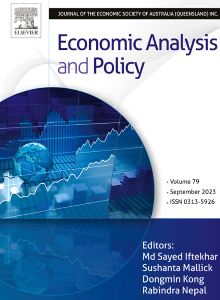Impact of unconventional monetary policy on stock market in selected economies during and post-COVID-19 pandemic
IF 8.7
2区 经济学
Q1 ECONOMICS
引用次数: 0
Abstract
This study investigates the impact and effectiveness of unconventional monetary policy (UMP) interventions, specifically central bank policy announcements and asset purchases programs, across four major advanced economies, namely the United States (US), European Union (EU), United Kingdom (UK), and Japan during and post-COVID-19 pandemic. By utilizing the EGARCH(1,1)-X-MIDAS framework, the model captures both short-run and long-run components of stock market volatility by incorporating mixed-frequency exogenous variables of policy announcement and asset purchases. Covering the period from March 2020 to December 2023, the findings reveal that policy announcements had transient or insignificant effects on volatility, especially as market participants adjusted to well-communicated policy regimes. In contrast, the impact of asset purchases varied by economy and period: the US experienced volatility-dampening effects, while the EU, UK, and Japan exhibited volatility amplification in response to sustained interventions. These effects were found to be state-dependent and time-varying, reflecting differences in institutional credibility, market expectations, and macro-financial conditions. Robustness checks using a GJR-GARCH(1,1)-X-MIDAS model confirm the consistency of results under asymmetric volatility dynamics. Overall, the study provides new empirical evidence on the conditional effectiveness of UMP, highlighting its transmission through the volatility channel rather than mean returns.
在2019冠状病毒病大流行期间和之后,非常规货币政策对选定经济体股市的影响
本研究调查了美国(US)、欧盟(EU)、英国(UK)和日本这四个主要发达经济体在covid -19大流行期间和之后的非常规货币政策(UMP)干预措施的影响和有效性,特别是央行政策公告和资产购买计划。通过利用EGARCH(1,1)-X-MIDAS框架,该模型通过纳入政策公告和资产购买的混合频率外生变量来捕获股票市场波动的短期和长期成分。在2020年3月至2023年12月期间,研究结果显示,政策公告对波动性的影响是短暂的或微不足道的,尤其是在市场参与者适应良好沟通的政策制度的过程中。相比之下,资产购买的影响因经济和时期而异:美国经历了波动抑制效应,而欧盟、英国和日本则因持续干预而表现出波动放大效应。研究发现,这些影响具有国家依赖性和时变性,反映了制度可信度、市场预期和宏观金融状况的差异。使用GJR-GARCH(1,1)-X-MIDAS模型进行鲁棒性检验,证实了不对称波动动力学下结果的一致性。总体而言,该研究为非常规货币政策的条件有效性提供了新的经验证据,突出了其通过波动率渠道而不是平均回报渠道的传导。
本文章由计算机程序翻译,如有差异,请以英文原文为准。
求助全文
约1分钟内获得全文
求助全文
来源期刊

Economic Analysis and Policy
ECONOMICS-
CiteScore
9.80
自引率
9.20%
发文量
231
审稿时长
93 days
期刊介绍:
Economic Analysis and Policy (established 1970) publishes articles from all branches of economics with a particular focus on research, theoretical and applied, which has strong policy relevance. The journal also publishes survey articles and empirical replications on key policy issues. Authors are expected to highlight the main insights in a non-technical introduction and in the conclusion.
 求助内容:
求助内容: 应助结果提醒方式:
应助结果提醒方式:


